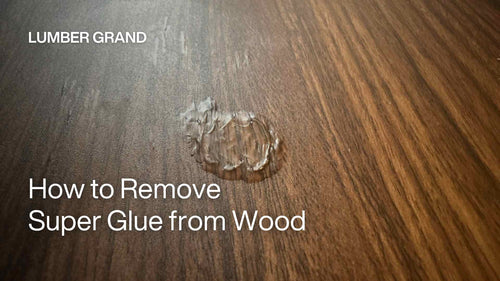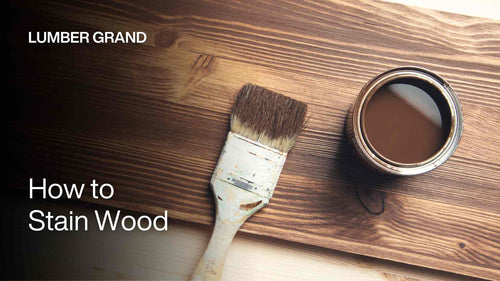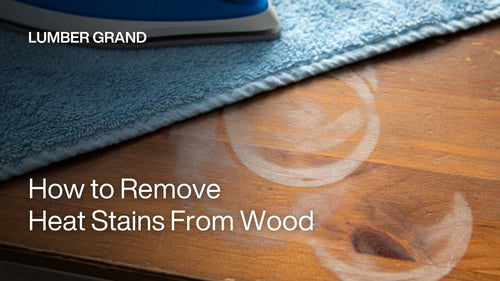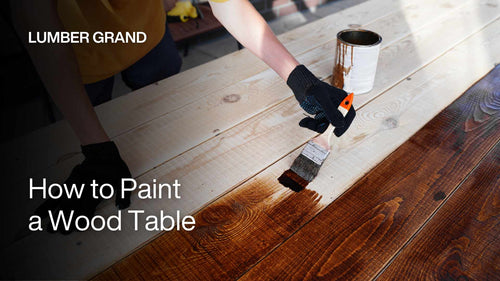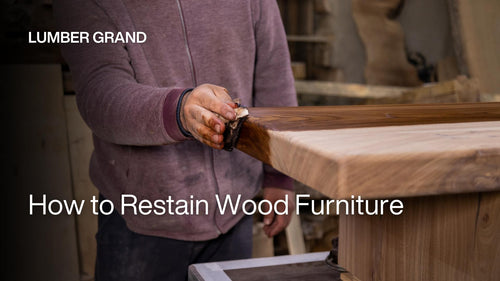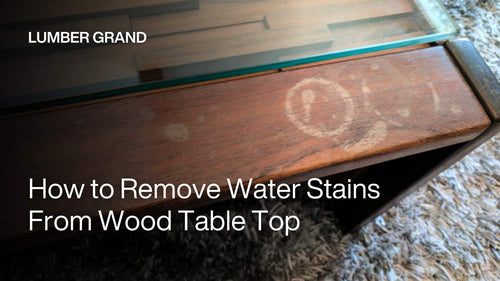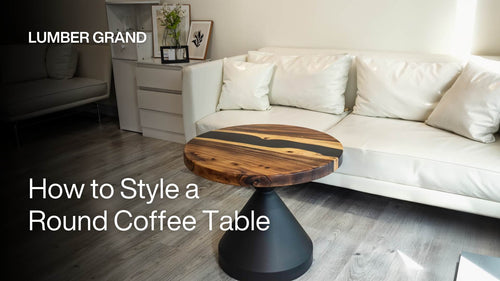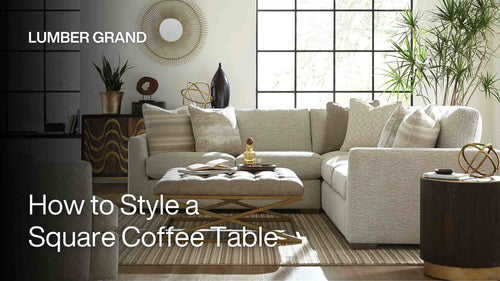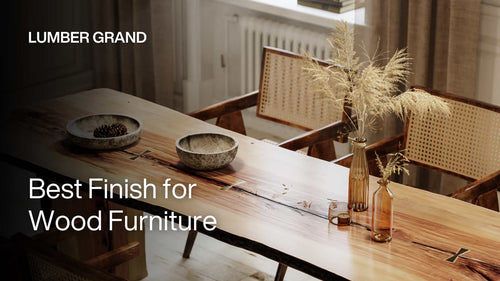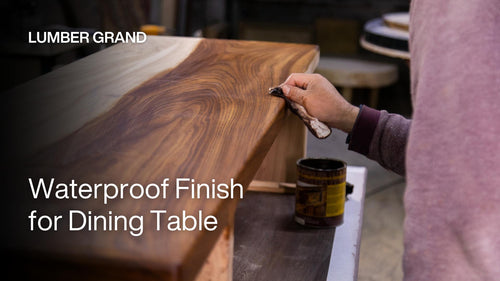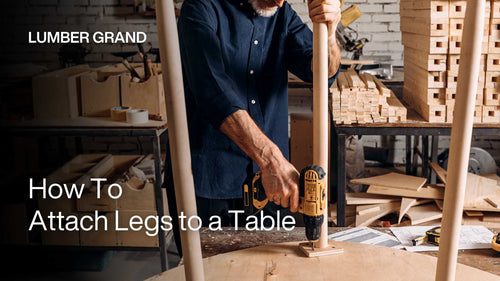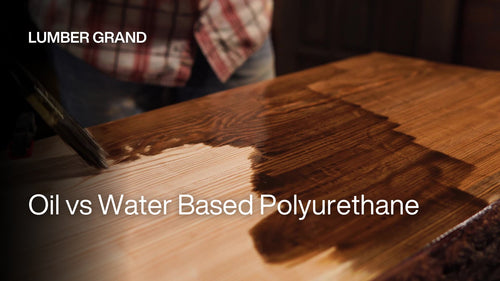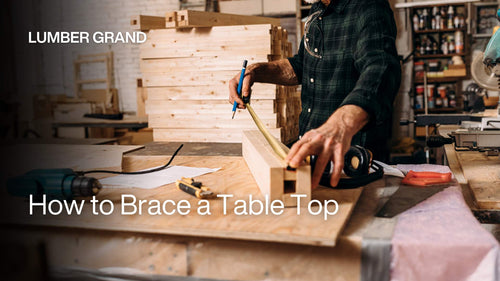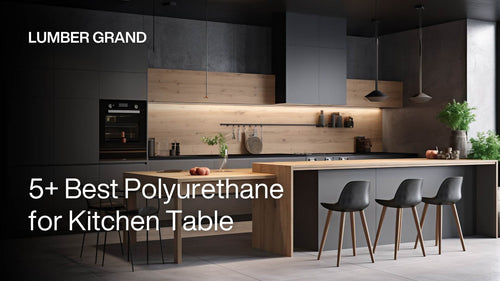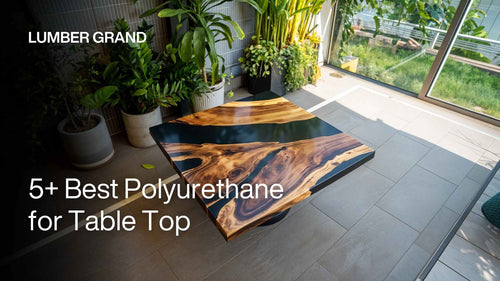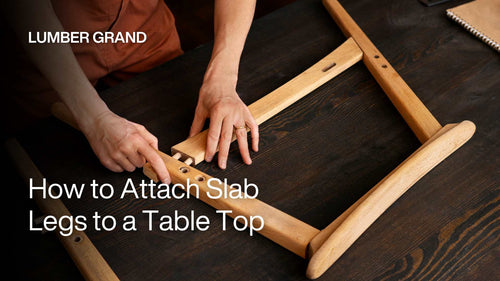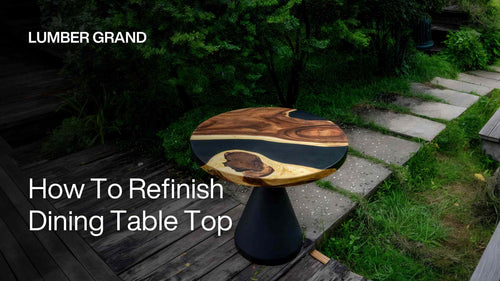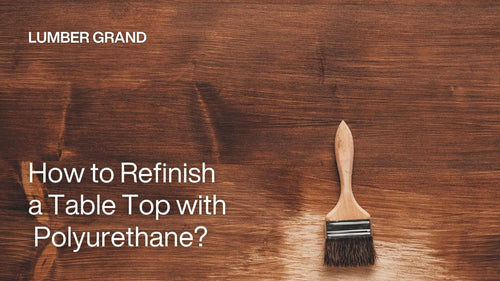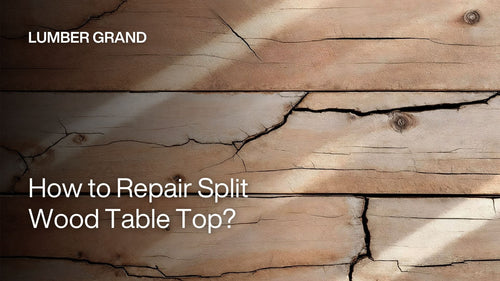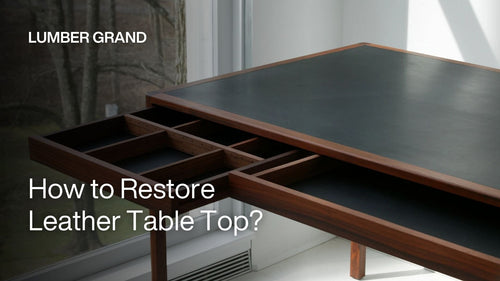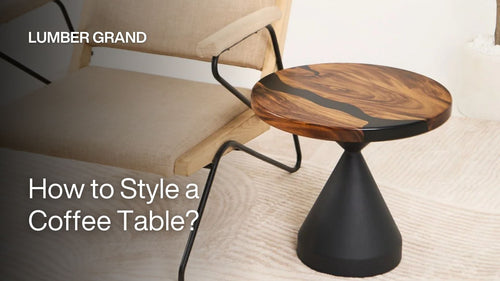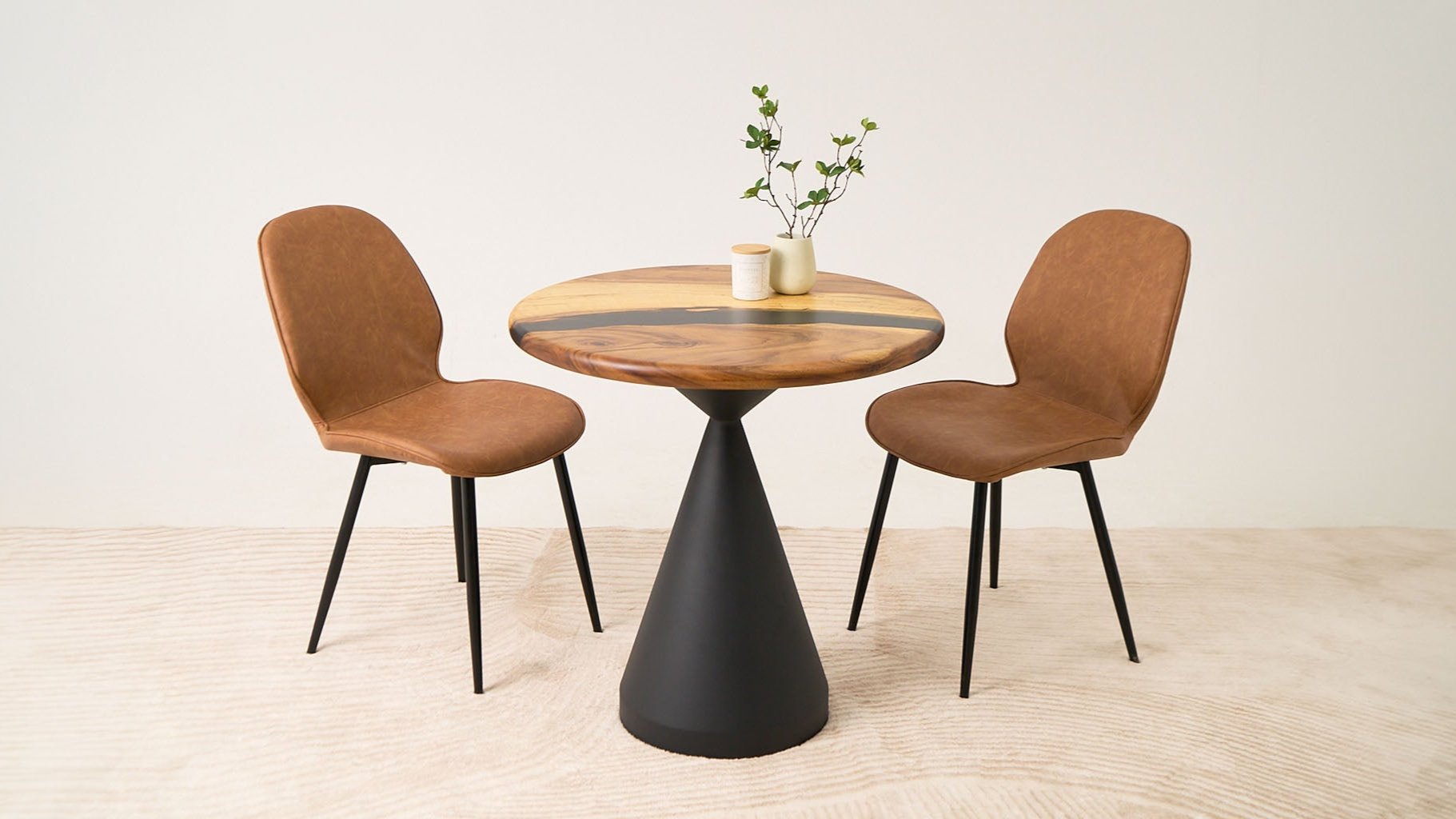When you're shopping for a dining table or thinking about building one, you might wonder: "How thick should a dining table top be?" It's actually a more important question than most people realize. No worries, Lumber Grand will walk you through everything you need to know about wood table top thickness. We'll keep it simple and practical so that you can make the best choice for your home and family.
So, what is the best thickness for a table dining room? Read more!
Why Table Top Thickness Matters?
The thickness of your table top makes a big difference in how strong it is, how it looks, and how comfortable it feels to use every day.
-
How it affects table strength and how long it lasts: A thicker wooden table top can hold more weight, especially if it's a long table or made from softer wood. Thick tops are much less likely to bend, crack, or sag over the years, even when you use them daily.
-
How it changes the way your table looks: A thin table top gives your table a light, modern feel. Conversely, a thick top makes it look bold and solid. The thickness you choose changes the whole personality of your table.
-
Getting the right mix of comfort, looks, and usefulness: The best thickness makes your table comfortable to sit at and looks balanced with the legs and base. If it's too thick, it might hit your knees when you sit down. If it's too thin, it might look weak and flimsy.

How thick should a dining table top be depends on how you plan to use your table
Credit: Lumber Grand
Shop now: Round Black Epoxy Resin Dining Table Top 41" Diameter
How Thick Should a Dining Table Top Be for Your Home?
Dining table tops should be between 1 and 2 inches thick, depending on what shape they are and how you'll use them.
-
1 - 1.5 inches: Well-balanced, sleek-looking, and easier to move around. These work great for apartments or modern home styles.
-
1.5 - 2 inches: They’re thick and very sturdy. No wonder why, these table top thicknesses are perfect for open floor plans or farmhouse-style homes.

A dining table top should have a thickness of 1 to 2 inches
Photo: Lumber Grand
1. Ideal Table Top Thickness for Different Interior Styles
Choosing the right dining table top thickness depends heavily on your interior style. Here's a breakdown of the best thickness ranges based on popular table design aesthetics:
-
Traditional dining table top thickness (1.5" – 2"): The best dining table top thickness for traditional style is between 1.5" and 2" thick. Classic tables look their best with fancy details and turned legs, and this thickness works perfectly with the decorated base to give you that substantial look.
-
Modern dining table top thickness (1" – 1.25"): Modern dining table tops should be 1" to 1.25" thick. Modern designs look better with thin, clean lines, and this thickness gives you that sleek, light appearance without making the table weak, especially when you pair it with metal or angular legs.
-
Table top thickness works for transitional style tables that mix old and new (1.25" – 1.5"): The best dining table top thickness for transitional style tables is 1.25" to 1.5" thick. Balance is what transitional tables are all about, and this thickness keeps your table from looking too heavy or too plain, which brings both old and new styles together perfectly.
2. Recommended Thickness by Wood and Material Types
Our experts suggest the best table top thickness based on what wood type/material your table top is made from for dining rooms.
|
Material Type |
Small Tables (<4 feet) |
Medium Tables (4 — 6 feet) |
Large Tables (6 — 8 feet) |
Extra Large Tables (8+ feet) |
Notes |
|
SOLID HARDWOODS |
|||||
|
Oak |
1" — 1.25" |
1.25" — 1.5" |
1.5" — 1.75" |
1.75" — 2" |
Excellent strength-to-weight ratio |
|
Maple |
1" — 1.25" |
1.25" — 1.5" |
1.5" — 1.75" |
1.75" — 2" |
Very dense, can use minimum thickness |
|
Cherry |
1" — 1.25" |
1.25" — 1.5" |
1.5" — 1.75" |
1.75" — 2" |
Moderate density, standard thickness |
|
Walnut |
1" — 1.25" |
1.25" — 1.5" |
1.5" — 1.75" |
1.75" — 2" |
Dense but can be brittle |
|
Mahogany |
1" — 1.25" |
1.25" — 1.5" |
1.5" — 1.75" |
1.75" — 2" |
Stable, less prone to warping |
|
Ash |
1" — 1.25" |
1.25" — 1.5" |
1.5" — 1.75" |
1.75" — 2" |
Very strong, flexible |
|
Hickory |
0.75" — 1" |
1" — 1.25" |
1.25" — 1.5" |
1.5" — 1.75" |
Extremely dense and strong |
|
SOFTWOODS |
|||||
|
Pine |
1.25" — 1.5" |
1.5" — 1.75" |
1.75" — 2" |
2" — 2.25" |
Needs extra thickness for strength |
|
Cedar |
1.25" — 1.5" |
1.5" — 1.75" |
1.75" — 2" |
2" — 2.25" |
Light but soft, needs thickness |
|
Fir |
1.25" — 1.5" |
1.5" — 1.75" |
1.75" — 2" |
2" — 2.25" |
Stronger than pine |
|
ENGINEERED MATERIALS |
|||||
|
Plywood (Hardwood veneer) |
0.75" — 1" |
1" — 1.25" |
1.25" — 1.5" |
1.5" — 1.75" |
Very stable, minimal movement |
|
MDF with veneer |
1" — 1.25" |
1.25" — 1.5" |
1.5" — 1.75" |
1.75" — 2" |
Heavy but stable |
|
Particle board with veneer |
1.25" — 1.5" |
1.5" — 1.75" |
1.75" — 2" |
Not recommended |
Prone to sagging |
|
Butcher block |
1.5" — 1.75" |
1.75" — 2" |
2" — 2.25" |
2.25" — 2.5" |
Laminated strips, very strong |
|
SPECIALTY MATERIALS |
|||||
|
Epoxy resin tables |
1.5" — 2" |
2" — 2.5" |
2.5" — 3" |
3" — 3.5" |
Needs thickness for weight distribution |
|
Live edge slabs |
1.5" — 2" |
2" — 2.5" |
2.5" — 3" |
3" — 4" |
Natural edge adds visual weight |
|
Reclaimed wood |
1.25" — 1.5" |
1.5" — 1.75" |
1.75" — 2" |
2" — 2.25" |
Depends on the wood condition |
Additionally, Lumber Grand handcrafted epoxy tables follow these natural proportions so they look good and last a long time.

How thick should a dining table top be? For solid wood, most standard dining tables are between 1.5 and 2 inches thick
Credit: Lumber Grand
Shop Now: Square Epoxy Dining Table Top 41" x 41"
3. Table Top Thickness Guidelines by Table Shape
The shape of your table affects how thick the top should be. We’ve made this guide so you can find the right balance for your dining table. Let's take a look at ideal table top thickness mm and inches for different shapes:
|
Shape |
Small/Medium Table (≤6 ft) |
Large Table (>6 ft) |
Style/Notes |
|
Rectangle |
¾" — 1" (19 — 25 mm) |
1" — 1½" (25 — 38 mm) |
Thicker tops (1¼" — 2") for rustic or statement tables |
|
Square |
¾" — 1" (19 — 25 mm) |
1" — 1½" (25 — 38 mm) |
Similar to rectangular, you need a thicker top for larger diameters |
|
Round |
¾" — 1" (19 — 25 mm) |
1" — 1½" (25 — 38 mm) |
Proportionally thicker for very large squares |
In short: When considering table top thickness cm, these measurements translate to approximately 1.9 — 2.5 cm for smaller tables and 2.5 — 3.8 cm for larger tables. The right table top thickness mm above, will ensure your table is both structurally sound and visually proportioned to its size and shape.
Discover the beauty Handcrafted Square Table Top Collection.
4. Choosing Table Top Thickness Based on Lifestyle Needs
-
Table top thickness for busy families: For busy families, your dining table should be 1.5" or thicker. Homes with kids, pets, and lots of family gatherings need this thickness because it handles wear and tear better and stays stable through all the daily use.
-
Table top thickness for formal dining rooms: For formal dining rooms, your table should be 1.25" to 1.5" thick. If your table is mainly for entertaining guests rather than everyday meals, this wood table top thickness gives you the right look and function without being too bulky.
How Do You Match Dining Table Top Thickness to Leg Width?
Your table legs and top thickness need to work together to look balanced. A thick, heavy top with skinny legs can look top-heavy and unstable. On the other hand, a thin top with chunky legs can look out of proportion.
Here's the right pairing for table top thickness and table leg thickness:
-
1" — 1.25" table top: Pair with legs that are 2" to 3" wide
-
1.5" table top: Pair with legs that are 3" to 3.5" wide
-
2" table top: Pair with legs that are 3.5" wide or more
How to Measure Dining Table Top Thickness
The table top thickness you choose directly affects the final height of your table, which impacts legroom and overall usability. By following these three simple steps, you'll calculate the maximum thickness that works with your existing base and ensure comfortable seating for everyone.
Step 1. Figure Out Your Table Height
Most dining tables work best at 28 — 30 inches tall from the floor to table top. This height works well with regular dining chairs and gives your legs plenty of room.

Getting the right thickness for your dining table top
Credit: Lumber Grand
If you already have chairs you love, sit in one and measure from the floor to the top of your thighs. Then, you add 10 — 12 inches to that number, and that's your ideal dining table height.
Step 2. Measure Your Dining Table Base
Secondly, you take a measuring tape and measure from the floor up to the spot where your table top will sit. This is your base height. For example, if your base measures 27 inches from floor to top, write that number down.
Step 3. Do the Simple Math
Lastly, we take your ideal table dining height (usually 29 inches) and subtract your base height.
29 inches - 27 inches = 2 inches
This formula means your dining table top can be up to 2 inches thick. You can go thinner, but not thicker, or your knees won't fit comfortably underneath.
Quick Decision Guide: What Dining Table Top Thickness Should You Choose?
If you're still wondering what thickness is right for your dining table, follow this guide to match your choice with your table size, how you'll use it, and your style. It's about getting the exact number perfect and what looks and feels right in your space and holds up to how you live.
|
Usage Category |
Thickness Range |
Seating Capacity |
Best Applications |
|
Small Tables & Light Use |
¾" to 1" |
2 — 4 people |
|
|
Medium Tables & Everyday Family Use |
1" to 1.5" |
4 — 6 people |
|
|
Large Tables & Heavy Use |
1.5" to 2" |
6 — 10+ people |
|
|
Design-Focused Tables |
1.5"+ |
Varies |
|
|
Minimalist & Sleek Designs |
1" to 1.25" |
2 — 6 people |
|
Pro tips: Remember to always think about how thick should table legs be and how they'll look in your room. A heavy top with thin legs looks unbalanced, and a thin top on thick legs might look too small.
As a general rule, 1" to 2" is usually your safest bet. It works for most situations, holds up well with solid wood materials, and looks good with many different styles.
FAQs:
1. What Is the Best Thickness for a Dining Table Top?
The best thickness for a dining table top is between 1" and 2". Yet, the thickness will strongly depend on your style and how you use it. For most families, 1.5" works great because it's strong enough for daily use but not too heavy.
2. Is 3/4 Thick Enough for a Table Top?
3/4" (0.75-inch) can work for a table top, but only for smaller tables with really good support underneath. For dining tables that get regular use, you'll want to go thicker, like at least 1" or more, for better strength and durability.
3. How Thick Should a Slab Table Top Be?
A slab table top should be 1.75" to 2" thick or even thicker. Since slab tables are meant to show off the natural beauty of the wood and often span longer distances, they need this extra thickness for both looks and structural support.
How Thick Should a Dining Table Top Be: Guide Ends Here
At Lumber Grand, we understand that every family's needs are different. Whether you choose one of our handcrafted tables or decide to build your own, the most important thing is that you end up with a table that brings your family together around great meals and lasting memories.
Here's what to remember about “How Thick Is a Wood Table Top”:
-
For most families, a table top between 1 and 2 inches thick works perfectly. It's strong enough for daily use, looks good in most dining rooms, and won't break the bank.
-
If you have a large family or entertain often, consider going a bit thicker — around 1.5 to 2 inches. Your table will handle heavy use better and make a beautiful statement in your dining room.
-
For smaller spaces or modern styles, you can go thinner, around 1 to 1.25 inches. Still, please make sure the table has good support underneath.
Learn more: How to make a wood table top
Till these lines, we do hope you have your answer for the question “how thick should a dining table top be?”. The right thickness is determined by how you live, the materials you love, and the aesthetic statement you want to make. Thank you for reading!









